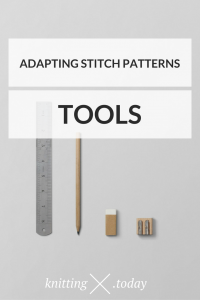Tools and Helpers for Adjusting Stitch Patterns
The number one question I’m asked about shawl design is about adapting stitch patterns to fit certain shawl shapes, especially for lace stitch patterns. Different shawl shapes need different stitch patterns and these articles about adjusting stitch patterns teach you how.
This post is part of my article series about adapting stitch patterns. You can browse the table of contents here:
Adapting Stitch Patterns for All Shawl Shapes: Table of Contents
Do You Really Need Tools?
When we talk about adjusting stitch patterns for various shawl shapes we have to talk about charts. To make a long story short: You will not be successful in adjusting stitch patterns is you refuse to use charts. Period. If you still refuse to use charts please ignore the rest of this article because it simply won’t help you in any way. You have been warned.
Adjusting stitch patterns is all about charting, and we can do this by hand using paper and pencil or use software to assist us. Personally, I’m using both charting software and sometimes paper and pencil to experiment or fine tune a stitch pattern.
Charting Software
Charts can be created using a variety of tools – from using knitting fonts in your favorite text editor, using Excel or Google Sheets or by using software which has been created especially for charting.
Using Spreadsheets
Similar to creating charts with spreadsheets using knitting fonts like described above, you can use spreadsheets without knitting fonts but choosing your own knitting symbol table you create. For instance, you can use “x” for purls, empty squares for knit stitches, “b” for knit through back loop, and so on.
Charting Software
There’s a lot of software for creating knitting charts (and sometimes they include more features than just creating charts) on the market. To name a few: Intwined Pattern Studio, EnvisioKnit, and Knit Visualizer are only a few popular examples.

I chose to use Knit Visualizer back in 2012 and did not regret it ever since. It has some minor disadvantages when it comes to exporting images – the exports always come with with frames I had to edit out, for instance. Mirroring charts does not mirror the decreases which is annoying, but I have to say in the end I’m a happy Knit Visualizer user. The generated charts are looking professional and are clear and intuitive to read too.
Summary
If you’re serious about adjusting stitch patterns you’ll need to use charts and some kind of charting software. This can be any spreadsheet software or such made especially for charting and design, like the examples mentioned above.
Part #3 will be online tomorrow: We’ll talk about adapting charts for triangle shawls. See you then!
Do you have experience with charting or other knitting software? If yes, please let me know by leaving a comment below!


Hi Julia!
I am not financially able to purchase any type of software needed for pattern design at this time, so I was wondering if you have an idea of any free options?
Thank you kindly!
Trish ✌️
Trish,
yes I do, and I talked about those in the Shawl Design Bootcamp in 2015: Use Excel or Google Sheets (with a free knitting font eventually), and Word (or Google Docs, or a similar software). You won’t find free charting software though, I’m afraid! (Working at it …)
Pingback: Adapting Stitch Patterns: How to Fit Stitch Patterns to Shawl Shapes